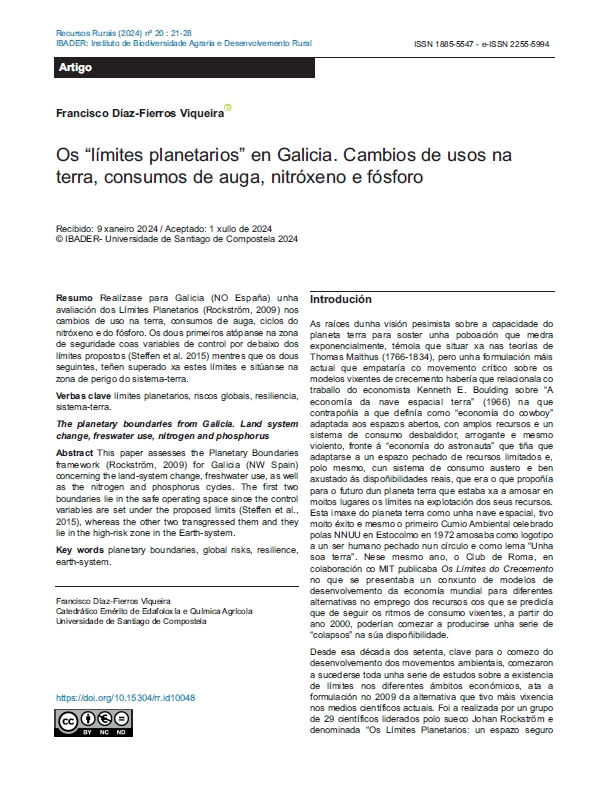The planetary boundaries from Galicia. Land system change, freswater use, nitrogen and phosphorus
Main Article Content
Abstract
This paper assesses the Planetary Boundaries framework (Rockström, 2009) for Galicia (NW Spain) concerning the land-system change, freshwater use, as well as the nitrogen and phosphorus cycles. The first two boundaries lie in the safe operating space since the control variables are set under the proposed limits (Steffen et al., 2015), whereas the other two transgressed them and they lie in the high-risk zone in the Earth-system.
Keywords:
Article Details
References
Álvarez, M. Puertas, J. & Díaz-Fierros,F. (2001). Análisis regional de avenidas en la zona atlántica de Galicia, noroeste de España. Ingeniería Hidraúlica de México XVI(2): 67-76.
Biermann,F. & Kim, R.E. (2020). The Boundaries of the Planetary Boundary Framework: A Critical Appraisal of Approaches to Define a “Safe Operating Space” for Humanity. Ann. Rev. Environm. Resourc. 45: 497-521.
Boulding, K. (1966). The Economics of the Coming Spaceship Earth. In: H.Jarret (ed.): Environmental Quality in a Growing Economy. John Hopkins Univ. Press. Baltimore.
Carballas,T. & Díaz-Fierros, F. (1990). El purín de vacuno en Galicia. Caracterización, poder fertilizante y problemas ambientales. Xunta de Galicia. Santiago de Compostela.
Dao H, Pedrzzi P & Friot D. (2018). National environmental limits and footprints base don the planetary boundaries framework: the case in Swizerland. Glob. Environm. Change 52: 49-57.
Dearing JA, Wang R, Zhang K, Dyke JG et al. (2014). Safe and just operating spaces for regional social-ecological systems. Glob.Environm. Change 28: 227-238.
Díaz-Fierros,F., Núñez, A. & López, E. (1993). As concas fluviais de Galicia. Universidade de Santiago de Compostela. Santiago de Compostela.
Fanning, A.l. & O´Neill, D.W. (2016). Tracking resource use relative to planetary boundaries in a steady-state framework. A case study of Canada and Spain. Ecol. Indicators 69: 836-849.
FAO. (2022). World Food and Agriculture – Statistical Yearbook 2022. Roma.
Hoff H, Nykvist B & Carson M. (2014). Living well, whithin the limits of our planets? Measuring Europe´s growing external footprint. Stockolm Environment Institute. Stockolm.
Instituto Galego de Estatística (2020). Distribución de superficies segundo usos (ano 2020).
MAPA (2018). Balance de nitrógeno 2016. Madrid.
Marquet, P.A. et al. (2022). Las tres brechas del desarrollo sostenible y el cierre de la brecha ambiental en Chile: oportunidades para una recuperación postpandemia más sostenible y con bajas emisiones de Carbono en América Latina y el Caribe. Documentos de Proyectos (LC/TS. 2022/35) CEPAL. Santiago de Chile.
Meadows, D.H et al. (2022). Os límites do crecemento. Ed. Galaxia, Vigo.
Ministerio de Agricultura, Pesca y Alimentación. Plan Nacional de Regadíos. Horizonte 2008 https://www.mapa.gob.es/es/desarrollo-rural/temas/gestion-sostenible-regadios/actuaciones-regadios/default_2.1.1.1.aspx.
Ministerio de Medio Ambiente (2000). Libro Blanco del Agua en España. Madrid.
MITECO (2022). Informe de seguimiento de los Planes Hidrológicos de Cuenca y de los recursos hídricos de España. Año 2021. Madrid.
MITECO (2023). Estado de los nitratos en España www. miteco.gob.es/es/agua/temas/estado-y-calidad-de-las-aguas/protección-nitratos-pesticidas/documentos-publicaciones.html.(consultado o 17/12/2023).
MITECO (2023). “La eutrofización en España. www.miteco.gob.es/es/agua/tem as/estado-y-calidad-de-las-aguas/proteccion-eutrofizacion/eutrofizacion-espana.html (consultado o 17/12/2023)
Neira Seijo, X., Paz González, A., Alvarez López, C. & Velo Sabin, R. (1994). Sistemas de regadío en Galicia. Semana Verde de Galicia. Agricultura: 392-393.
Nykvist B., Person A., Moberg, F., Person, L., Cornell, S. & Rockström, J. (2013). National environmental performance on planetary boundaries: a study for the Swedish Environmental Protection Agency. Rep. 6576, Swde. Environm. Protect. Agency. Stockholm.
Pastor, A.V., Ludwing, F., Biemans, H., Hoff, H. e Kabat, P. (2014). Accounting for environmental flow requirements in global water assessments. Hydrol. Earth Syst. Sci. 18: 5041-5059.
Raworth K. (2017). A doughnut for the Anthropocene: humanity´s compass in the 21st century. The Lancet 1.
Richardson, K. et al. (2023). Earth beyond six of nine planetary boundaries. Science Advances, 9 (37), eadh2458: 1-16.
Río Barja, F. & Rodriguez Lestegás, F. (1992). Os ríos galegos. Consello da Cultura Galega. Santiago de Compostela.
Rockström, J.W. et al. (2009) Planetary boundaries: exploring the safe operating space for humanity. Ecology and Society, 14 (2). URL:http/www.ecologyandsociety. org/vol14/iss2/art 32/
Steffen, W. et al. (2015). Planetary boundaries: Guiding human development on changing planet. Science 347, (6223): 1-10. 1259855. (máis Supplementary Materials).
De Vries W., Kros J., Kroeze C. & Seitzinger S.P. (2013). Assessing planetary and regional nitrogen boundaries related to food security and adverse environmental impacts. Curr. Opinion Environm. Sustainabilitty 5(3-4): 392-402.
Xunta de Galicia (2023). Primeiros resultados do Inventario Forestal Continúo de Galicia. Santiago.
Zanon, M., Basil, A., Davis, S., Marquer, L., Brewer, S. & Kaplan, JO. (2018). European Forest Cover During Past 12.000 years: A Palynological Reconstruction Base on Modern Analogs and Remore Sensing. Frontiers Plan Sci.9.253. 10.3389/fpls.2018.00253.
Most read articles by the same author(s)
- Eduardo José Corbelle Rico, David Vila García, Rafael Crecente Maseda, Francisco Díaz-Fierros Viqueira, Dixitalización do Mapa de capacidade produtiva dos solos de Galicia , Recursos Rurais: No 10 (2014)
- Francisco Díaz-Fierros Viqueira, The tree of controversy. Effects of the eucalyptus on the hydrological resources, soils and biodiversity in Galicia , Recursos Rurais: No 15 (2019)






